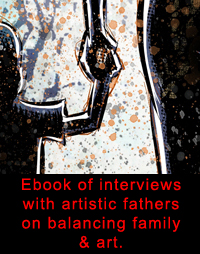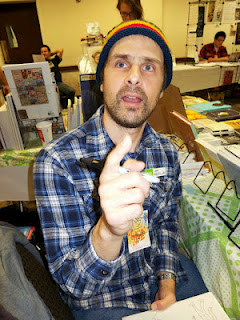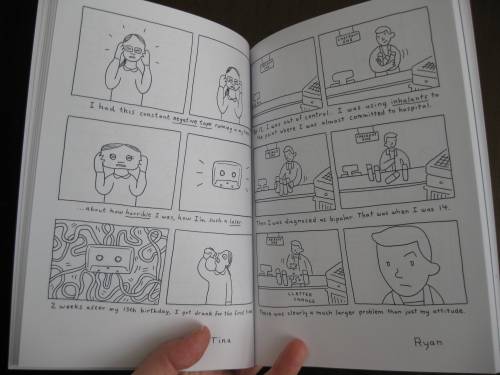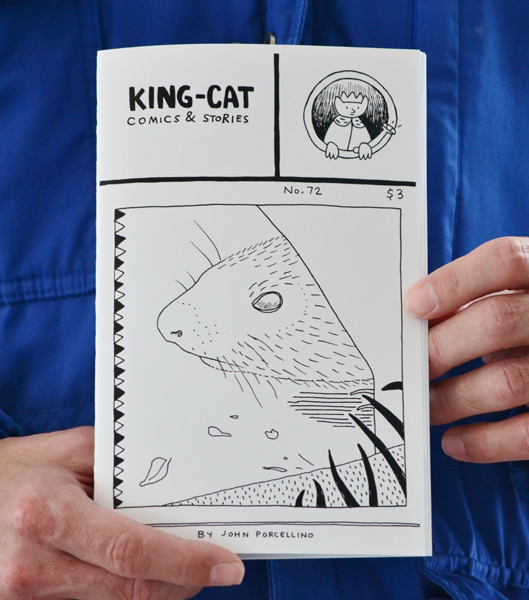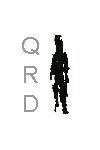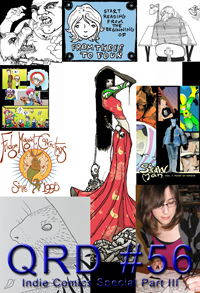
July 2012
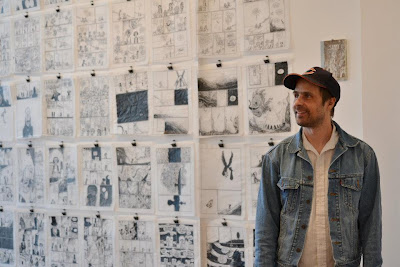
City: South Beloit, IL
Comics: King-Cat Comics & Stories
Websites: www.king-cat.net, www.johnporcellino.blogspot.com, www.spitandahalf.blogspot.com
QRD – How old were you when you first got into comics & did you always stick with them or did you come back to them?
John – As a kid I read the newspaper funnies & drew comics based more on monster movies, etc. than any real knowledge of comic books. I only ever had a handful of comic books as a boy, mostly supernatural chillers, a handful of superhero comics. For a year or two I made D&D type spoof comics that I photocopied & gave to my friends at school. It wasn’t till I was in high school & had a friend who read Marvel comics that I started really getting into the comic book scene. I read Marvel comics for 6 months or a year before I discovered Love & Rockets, Neat Stuff, Lloyd Llewellyn, Neil the Horse etc. Around the same time I discovered the comic strips of Lynda Barry & Matt Groening, in the Chicago Reader, & those were the big two that made me start thinking about comics in a different way, & wanting to make my own comics again.
QRD – What was the first comic book you ever bought?
John – Chamber of Chills #15, March 1975, Marvel Comics.
QRD – How old were you when you put out your first comic?
John – I’m guessing eight years old or nine. It was called “Invasion of the Incredible Blobs.”
QRD – What decade do you think produced the best comics?
John – All decades produced their standout works.
QRD – Why comics instead of just writing or drawing?
John – To me, for as long as I can remember I was drawing & writing, but I was also obsessed with the book form. It was only natural that as time went on I tried to make my own books. I continued on making little comics & booklets as I studied fine art. Around my senior year in college I realized that self-published comics were the perfect medium for me -- they encompassed so many of my interests: writing, drawing, bookmaking, & being independent. Since that realization I’ve never looked back.
QRD – Do you see mini-comics & indie comics as paths to mainstream comics or as their own unique media?
John – God I hope not. As to being their own unique media, to me, they’re just comics. It’s all just comics. I don’t divide things up that way.
QRD – How many copies of your comic do you print in your first run?
John – King-Cat #1 was 18 copies, King-Cat #72 was 2000 copies.
QRD – How much do you think comics should cost?
John – Enough to make the creator a bit of money, but I believe comics should be affordable. That’s one of the big reasons I chose comics over gallery art.
QRD – How many books do you produce a year & how many would you like to?
John – Nowadays I usually produce one zine a year & about one book form project a year. I’d like to get it up to two zines a year, & a book too would be nice. That seems doable.
QRD – Do you think stories should be serialized or delivered as complete works?
John – Depends on the story & the artist’s goals. One is not inherently better than the other.
QRD – How are comic strips different than comic books & which medium do you prefer?
John – Well, when you say comic strips you’re talking about newspaper type strips, four panels at a time or something, right? Obviously that’s simply a different animal than a 32 page comic book, or a 200 page long form comics story. I just prefer good comics. I don’t care whether it’s a strip or a book.
QRD – How long is it from when you start a comic until it’s printed?
John – For the zines, about 6 months, for the books anywhere from a year to two.
QRD – What do you do better with your comics now than when you first started?
John – Make ‘em.
QRD – At what point in the artistic process do you work digitally?
John – After stuff is drawn & I have to scan it in for the printer.
QRD – What do you think of digital comics & webcomics?
John – I don’t pay attention to that kind of stuff too much. I have basically zero interest in reading a comic on a screen.
QRD – Do you prefer working in color or black & white?
John – Color is great & has its place, but nothing beats a delicious black & white to me.
QRD – How many different people should work on a comic & what should their jobs be?
John – One person, & they should make the comic.
QRD – How do you find collaborators?
John – Unnecessary.
QRD – How tight do you think a script should be as far as telling the artist what to draw?
John – I don’t think anyone should tell an artist what to draw.
QRD – What comic book person would you be most flattered to be compared to?
John – Charles Schulz.
QRD – What do your friends & family think of your comics?
John – My friends like ‘em. Most of my friends were made through comics. My family doesn’t read them.
QRD – What do you think of superheroes?
John – I like the classics. I’m more of a Kirby fan than a superhero fan, though.
QRD – Marvel or DC?
John – Marvel by a long shot, unless you’re talking OMAC or Fourth World, etc.
QRD – What comic characters other than your own would you like to work with?
John – The Great Lakes Avengers.
QRD – Ideally would you self-publish?
John – I do self-publish, & yes, it’s (nearly) ideal.
QRD – What conventions do you try to attend & why?
John – I go to the ones where there’s an independent spirit ? SPX, SPACE, Brooklyn, CAKE, MIX. I have pretty much given up on attending mainstream comics shows.
QRD – What do you do to promote your books?
John – I travel around the country a lot, doing signings & appearances. & I have several websites, post stuff on Facebook, etc. Mostly I’ve just relied on word of mouth & tried to be patient.
QRD – Do you think your comics are well suited to comic shops or would sell better elsewhere?
John – It depends on the shop & the clientele. My comics could be sold anywhere people are looking for good stuff to read. I like that there are such things as comic shops & I’m a vocal defender of them. But good comic shops are sadly becoming fewer & farther between. So I also sell my work in regular bookstores, boutiques, galleries, record stores, radical bookshops, at conventions, & online.
QRD – What other medium would you like to see some of your comics made into (television, film, games, action figures, etc.)?
John – Plush collectable dolls.
QRD – Do you consider yourself a comic collector or a comic reader or both?
John – The only comics I ever obsessively “collected” were the Marvel Monster reprints from the 70’s ? ”Where Monsters Dwell” et al. I like comics & I have a good collection of comics, but I’m not like a crazy collector.
QRD – What do you see as the most viable mediums for comics distribution 10 years from now?
John – I wish there was a great store, devoted to the entire spectrum of comics available, in every city & town.
QRD – What would you like to see more people doing with comics?
John – Reading them.
QRD – Anything else?
John – Keep on Chooglin’.






